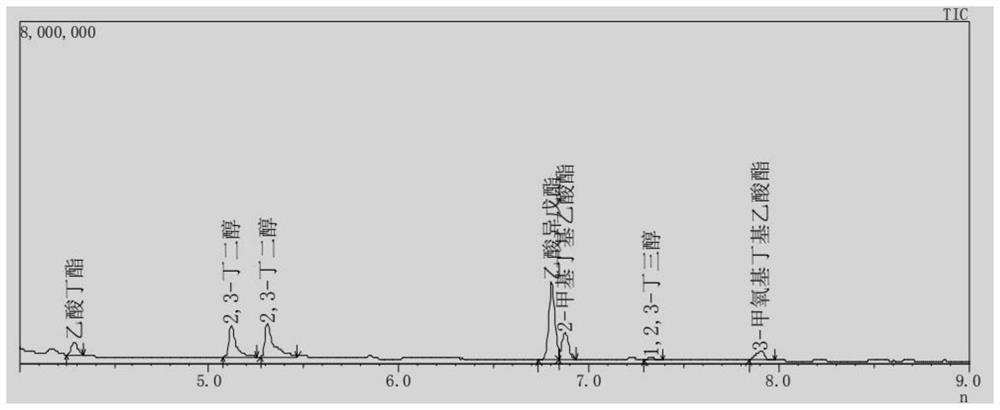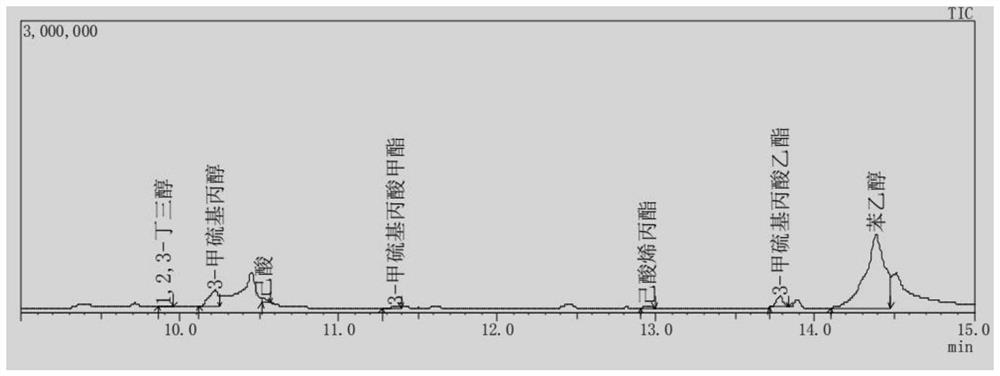Method for fermenting ananas comosus fruit vinegar by cell immobilization method
A technology of pineapple pulp and pineapple, which is applied in the field of fruit vinegar production, can solve the problems that the pineapple fruit vinegar does not last long, the accumulation of flavor components is not easy, and the development of pineapple is affected, so as to achieve the advantages of accumulation of flavor components, strong anti-oxidation function, The effect of increasing the accumulation of flavor components
- Summary
- Abstract
- Description
- Claims
- Application Information
AI Technical Summary
Problems solved by technology
Method used
Image
Examples
Embodiment 1
[0033] A method for fermenting pineapple fruit vinegar by cell immobilization method, comprising the steps of:
[0034] (1) Preparation of pineapple juice: Weigh an appropriate amount of pineapple pulp, crush and sterilize at 70-90°C, add 1‰ pectinase and cellulase, and filter to obtain pineapple juice after enzymatic hydrolysis;
[0035] (2) Strain activation: Alcoholic yeast, ester-producing yeast, lactic acid bacteria and acetic acid bacteria are prepared into a liquid with a mass concentration of 5‰, and activated for 5-8 hours respectively;
[0036] (3) Preparation of immobilized strains: Dissolve sodium alginate, chitosan, and gelatin in dilute hydrochloric acid solution according to a certain ratio, sterilize in a pressure cooker at 121°C for 20 minutes, and after cooling, use the strains prepared in step 2 Mix separately, drop into sterilized calcium chloride aqueous solution to obtain immobilized strains, put them in sterile bags, and store them at 1-4°C;
[0037] (4...
Embodiment 2
[0041] A method for fermenting pineapple fruit vinegar by cell immobilization method, comprising the steps of:
[0042] (1) Preparation of pineapple juice: Weigh an appropriate amount of pineapple pulp, crush and sterilize at 70°C, add 1‰ pectinase and cellulase, and filter to obtain pineapple juice after enzymolysis;
[0043] (2) Strain activation: Alcoholic yeast, ester-producing yeast, lactic acid bacteria and acetic acid bacteria were prepared into a solution with a mass concentration of 5‰, and activated for 5 hours respectively;
[0044] (3) Preparation of immobilized strains: Dissolve sodium alginate, chitosan, and gelatin in dilute hydrochloric acid solution according to a certain ratio, sterilize in a pressure cooker at 121°C for 20 minutes, and after cooling, use the strains prepared in step 2 Mix separately, drop into the sterilized calcium chloride aqueous solution to obtain immobilized strains, put them into sterile bags, and store them at 1-4°C;
[0045] (4) Alc...
Embodiment 3
[0049] A method for fermenting pineapple fruit vinegar by cell immobilization method, comprising the steps of:
[0050] (1) Preparation of pineapple juice: Weigh an appropriate amount of pineapple pulp, crush and sterilize at 90°C, add 1‰ pectinase and cellulase, and filter to obtain pineapple juice after enzymolysis;
[0051] (2) Strain activation: Alcoholic yeast, ester-producing yeast, lactic acid bacteria and acetic acid bacteria were prepared into a solution with a mass concentration of 5‰, and activated for 8 hours respectively;
[0052] (3) Preparation of immobilized strains: Sodium alginate, chitosan, and gelatin were dissolved in dilute hydrochloric acid solution according to a certain ratio, sterilized in a pressure cooker at 121°C for 20 minutes, after cooling, and the prepared in step (2) Mix the strains separately, drop them into the sterilized calcium chloride aqueous solution to obtain immobilized strains, put them in a sterile bag, and store them at 1-4°C;
[...
PUM
 Login to View More
Login to View More Abstract
Description
Claims
Application Information
 Login to View More
Login to View More - R&D
- Intellectual Property
- Life Sciences
- Materials
- Tech Scout
- Unparalleled Data Quality
- Higher Quality Content
- 60% Fewer Hallucinations
Browse by: Latest US Patents, China's latest patents, Technical Efficacy Thesaurus, Application Domain, Technology Topic, Popular Technical Reports.
© 2025 PatSnap. All rights reserved.Legal|Privacy policy|Modern Slavery Act Transparency Statement|Sitemap|About US| Contact US: help@patsnap.com



